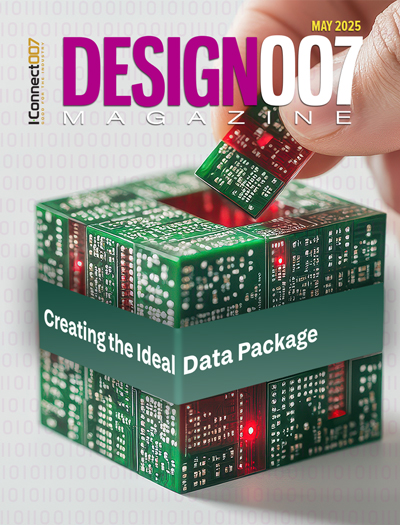-

- News
- Books
Featured Books
- design007 Magazine
Latest Issues
Current Issue
Creating the Ideal Data Package
Why is it so difficult to create the ideal data package? Many of these simple errors can be alleviated by paying attention to detail—and knowing what issues to look out for. So, this month, our experts weigh in on the best practices for creating the ideal design data package for your design.

Designing Through the Noise
Our experts discuss the constantly evolving world of RF design, including the many tradeoffs, material considerations, and design tips and techniques that designers and design engineers need to know to succeed in this high-frequency realm.

Learning to Speak ‘Fab’
Our expert contributors clear up many of the miscommunication problems between PCB designers and their fab and assembly stakeholders. As you will see, a little extra planning early in the design cycle can go a long way toward maintaining open lines of communication with the fab and assembly folks.
- Articles
- Columns
Search Console
- Links
- Media kit
||| MENU - design007 Magazine
Estimated reading time: 3 minutes
Maggie Benson’s Journey: Truth Revealed, Balance Restored
Editor’s note: Indium Corporation’s Ron Lasky continues this series of columns about Maggie Benson, a fictional character, to demonstrate continuous improvement and education in SMT assembly.
A meeting is transpiring at Ivy University, analyzing the cost of ownership calculations between Excel’s component placement machines and Pinnacle’s. In his analysis, Hal “Halitosis” Lindsey, the gruff salesperson from Excel, has demonstrated how Excel machines have a lower cost of ownership. Ivy U. student Paul LaCroix agreed with this analysis, and then shared his explanation of how the more expensive Pinnacle machines have a better profitability potential.
Upon hearing this, Hal began fuming. Just when he thought he had the sale, this young kid was messing things up. Yet, it wasn’t a surprise to him. “Professor Patty” had ruined his sales opportunities before, always with some “Ivory Tower” nonsense. Now, she was teaching kids like Paul this type of nonsensical analysis. But, he thought, it would be best to be quiet and listen to this kid before he said anything.
“Paul, can you explain to us your ‘profitability potential’ analysis?” Patty asked.
“Yes, Professor Patty,” Paul responded. “After discussions with Sue March, Andy Connors, Dr. Maggie, and you, it has become clear to me that ‘cost of ownership’ is an ineffective metric. Benson Electronics is in business to make money. Right now, business is booming, and they need more production capability. So, with quite a bit of coaching, I developed a spreadsheet that calculated the profitability potential of each of the component placement machines. While it is true that the Excel machines cost less to own, the Pinnacle machines produce more profit as they produce more PCBs in a given time.
“In the spreadsheet I developed (Figure 1), I calculated that the Pinnacle machines produce about 38,000 more PCBs per year than the Excel machines. This improved productivity would result in more than $400,000 in extra profit. This calculation includes the higher cost of ownership of the Pinnacle machines,” Paul elaborated.
When he heard this, Hal’s face turned red, he started shaking, and he blurted out, “Coleman, this is just another one of your Ivory Tower tricks that you teach these kids. You should be banned from teaching. My Excel machines have the lowest cost of ownership, and that is clear to everyone. By the way, everyone is calling you Professor Patty. Since the last time I have seen you, you have really packed on the pounds, so they should call you ‘Professor Fatty’ instead.”
At this, Professor Patty Coleman’s face turned red, and she looked crestfallen.
Andy Connor was outraged. With his fist raised, ready to strike, he made a beeline for Hal. Maggie rushed over to stop Andy, more to protect Andy than Hal, as Andy might get expelled from Ivy U if he struck Hal. At the same time, Maggie appealed for calm and asked a 6-foot-5-inch grad student, Mike Maple, to escort Hal out of the building and off campus.
With Hal out of the room, calm was restored, and Maggie began to speak.
“Paul that was an exceptional analysis,” she said. “Profitability potential is clearly more important than cost of ownership. So, we will buy the Pinnacle machines.”
Patty, still upset, but recovered enough to speak, turned to Paul and said, “I agree, and this is an excellent analysis. Do you think this analysis might also apply to consumables like solder paste?”
“Yes, Professor Patty,” Paul said. “Andy and Sue suggested as much. We found that a premium solder paste that has better response to pause and yield has much better profitability potential, even if it costs a few cents more per gram.”
Andy couldn’t hold back his thoughts about Hal. “I can see why they call him ‘Halitosis Hal,’” he said. “As I approached him, he gasped and his breath just about knocked me out.”
Everyone laughed but Patty. She just looked relieved that Hal was gone.
What is the profitability potential of your assembly equipment, solder paste, and other consumables? If you would like help calculating your profitability potential, contact Professor Lasky at rlasky@indium.com.
This column originally appeared in the November 2023 issue of SMT007 Magazine.
More Columns from Maggie Benson's Journey
Maggie Benson’s Journey: The Journey Was Worth ItMaggie Benson’s Journey: A Lesson From Elon Musk’s Playbook
Maggie Benson’s Journey: It’s Just One of Those Days
Maggie Benson’s Journey: The Big Reveal
Maggie Benson’s Journey: What Is the Profit Potential?
Maggie Benson’s Journey: A Tale of Two Lawn Mowers
Maggie Benson’s Journey: A ‘Cost of Ownership’ Project
Maggie Benson’s Journey: A Solution to the Cost-Estimate Problem


